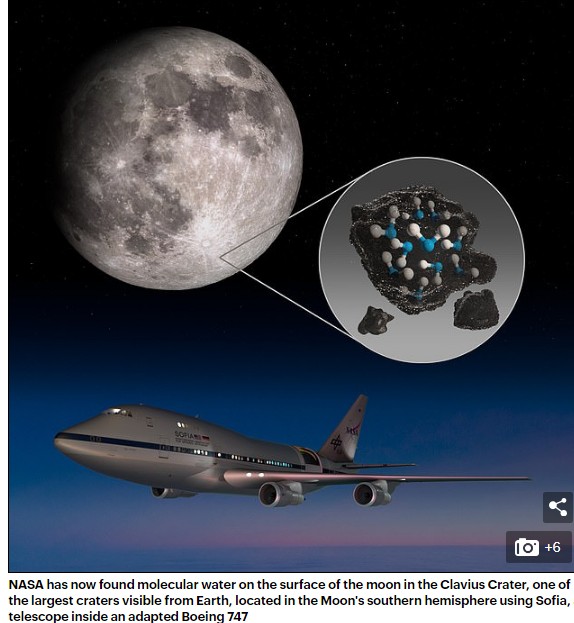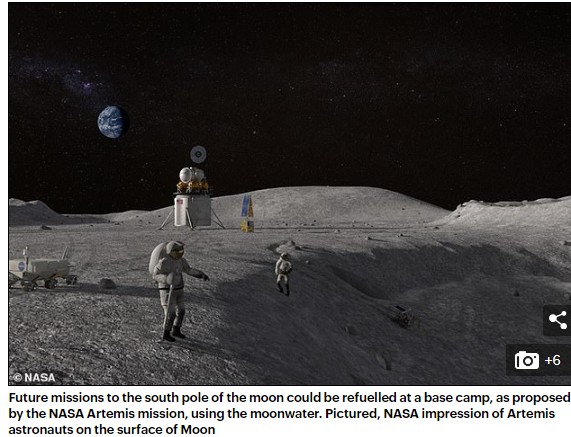

NASA has confirmed, for the first time, that there is water on the sunlit surface of the moon.

The revelation means it is possible water is easily accessible and not just in the deep, permanently shadowed craters of the south pole, as was previously thought.
A separate piece of research found these so-called ‘cold traps’, which are always in shadow, may contain up to 15,000 square miles (40,000 square km) of water.
The discovery means future missions to the moon could be prolonged by making use of these water molecules which are scattered across the moon.

Astronauts could use the natural resource, which may have arrived via comets or solar winds, and turn it into oxygen or drinking water to sustain a future colony.
Scientists also say the water could be used to make rocket fuel, lightening missions and slashing mission costs to make interplanetary space travel easier and cheaper.
Previously, researchers speculated water was only present in cold traps and were unable to prove it was water and not a similar molecule called hydroxyl, which is found in drain cleaner.

The NASA research used a converted Boeing 747 that cruises around Earth above the clouds at an altitude of more than 41,000ft called Sofia.
It was tasked with clarifying findings published in 2009 which discovered molecular hydrogen and oxygen on the surface of the moon.
However, due to the nature of the decade-old analysis, astronomers were unable to say whether or not it was water (H20) or hydroxyl (OH) compounds, the chemical found in drain cleaner, due to the similarity in their chemical signature.
Dr Nick Tothill, a physicist at Western Sydney University, who was not involved in the research, said: ‘The problem was that the water ice signature that was found before was really just telling us that there were oxygen and hydrogen atoms bound together.
‘On the Earth, this is mainly water, but on the Moon, you can’t be so sure.’

The issue was a limitation of the equipment that used a wavelength of three micrometres, which is unable to tell apart hydroxyl minerals from water.
Sofia, short for Stratospheric Observatory for Infrared Astronomy, is equipped with a unique six micrometre sensor that detects ‘a fundamental vibration of molecular water’ that is completely unique to water.
The Sofia study found the water molecules in Clavius Crater, one of the largest craters visible from Earth, located in the Moon’s southern hemisphere.
By detecting this, it is conclusive and indubitable proof of water on the sunlit surface of the moon, NASA says.
‘We had indications that H2O – the familiar water we know – might be present on the sunlit side of the Moon,’ said Paul Hertz, director of the Astrophysics Division in the Science Mission Directorate at NASA Headquarters in Washington.
‘Now we know it is there. This discovery challenges our understanding of the lunar surface and raises intriguing questions about resources relevant for deep space exploration.’
Dr Themiya Nanayakkara, an astronomer at Swinburne University of Technology, comments on the research.
‘Honniball and collaborators have now targeted a much higher wavelength feature at 6µm using data from the SOFIA observatory,’ he says.
He goes on to explain that Sofia is a modified Boeing 747 with a massive hole that fits in a 2.5-meter mirror.
‘They find spectral signatures that can only be explained by molecular water on the Moon,’ he says.
In the paper, published in the journal Nature Astronomy, the researchers say that water around the south pole of the moon is relatively abundant, at around 100 to 400 parts per million, equivalent to a 12-ounce (360ml) bottle of water – trapped in a cubic meter of soil.

This is about 100 times drier than the Sahara desert, NASA says.
‘We haven’t found a fountain or lake on the moon, the water density is very low, it is confined to the poles, and is likely trapped in glasses or rocks on the surface,’ warns Dr Ben Montet from the University of New South Wales.
The second scientific paper released today looks at where water is most likely to be found on the moon’s surface.
It adds to previous research which found that cold traps are well suited for preserving water ice.
Also known as topographic depressions, they benefit from a quirk of the moon’s physics, which is also a feature of Mercury and the asteroid Ceres.
All three are tilted on their axis and as a result the shadow created from their craters leaves some areas permanently in the shade.
In these areas, temperatures can plummet as low as -163.15°C/-261.67°F due to the lack of sunlight, hence the frigid moniker assigned by astronomers.
Dr Paul Hayne from the University of Colorado, Boulder led a project that tried to determine just how many of these there are and how much water they may contain.
His team used theoretical modelling and data from the Lunar Renaissance Orbiter (LRO) to piece this puzzle together.
They vary enormously in size, the researchers say, with some as large as one kilometre in diameter and some just one centimetre in width.
Up to a fifth of all water ice believed to be trapped in these spots is thought to be in the tiniest of the craters, the researchers say.
More than half (60 per cent) of the cold traps are in the south and the majority are at latitudes in excess of 80 degrees because ‘permanent shadows equatorward of 80° are typically too warm to support ice accumulation’, the researchers write.
In total, they speculate up to 40,000 square kilometres of water ice exists in the cold traps, the same as twice the contents of Lake Ontario.
Dr Tothill says: ‘Taken together, these papers tell us that there really is water ice on the moon, and it’s probably widespread over both polar regions – with a bit more in the south.
‘This in turn tells us how and where to look for water on the moon, with either robot or human explorers.’
While this research confirms long-held theories, astronomers have been acting on these suspicions for a long time.
NASA, for example, banked on finding water and plans to build a base camp at the moon’s south pole. Israel’s failed Beresheet mission also had a similar thought process.
Before a crash landing, it had intended to touch down in the lowland area of Mare Serenitatis. This area gave off a distinct signal indicating water is present there.
Thousands of dried tardigrades were secretly sent on this mission and these creatures are known as being the hardiest creatures in the world.
They can be revived by water, survive UV rays and Israel hoped to see if they would survive on the moon.
‘But we don’t have to worry that tardigrades are now running around the Moon,’ says Alice Gorman of Flinders University, a leading space archaeologist.
‘They’re encased in resin, and the water is most likely trapped inside glasses formed by micrometeorite impacts.’
The discovery, which was tantalisingly teased by NASA last week, has significant implications for future space missions to our natural satellite.
Dr Jonti Horner from the University of Southern Queensland calls the research ‘definitely exciting’.
He says future missions to the south pole of the moon could be refuelled at a base camp, as proposed by the NASA Artemis mission, using the moonwater.
But the implications are far more significant than that, experts say.
Instead of simply refuelling and returning to Earth, the presence of moonwater , and therefore lower costs for return trips, also open the door for interplanetary missions.
‘To launch a litre bottle of water from Earth to the Moon costs $35,000 – almost the same cost as if we just made that bottle solid gold, says Professor Alan Duffy, lead scientist of The Royal Institution of Australia.
‘But by accessing it directly from the Moon itself we turn our celestial neighbour into a resupply as well as a refuelling station.
‘Water can directly support astronauts on a planned Moon-base, used to grow food on long-duration missions to Mars, and even split into literal rocket fuel for powering our satellites and rockets across the Solar System. ‘
Source:- Daily Mail
SPONSORED LINKS
[TRENDING SONG!!] Romani D-Fans – Bestie (Prod By Krizbeatz)
[TRENDING MIXTAPE!!] DJ Baddo – Bestie Unlimited Mix
[TRENDING SONG!!] TYSG Ft Bad Mz X Kendi Rozzi – Iyariya
INSTALL 9JAFLAVER MUSIC APP, STREAM, DOWNLOAD, AND PLAY MUSIC OFFLINE
CHECK OUT FUNNY PICTURE AND MEME HERE (CLICK HERE)
Chissom Anthony – Glory To God In The Highest [See Trending Gospel Song]
© 2014-2023 9jaflaver. All Rights Reserved.
About us | DMCA | Privacy Policy | Contact us
| Advertise| Request For Music | Terms Of Service
9jaflaver is not responsible for the content of external sites.